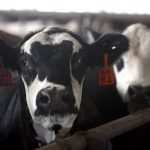
“It’s not a state by state issue,” said Executive Director of the Indiana Dairy Producers Doug Leman, citing similar struggles across the Midwest and the entire country. “It’s a general industry issue.”
In 2018 alone, Leman says 10 percent of all Indiana dairy farms stopped production. One of those farms was Kelsay Farms, which stopped milking on November 20.
“Just walking around here, it’s like the rapture happened and we didn’t go,” owner Joe Kelsay said while walking through the building that once housed 500 cows, most of which have now been sold. “It’s so quiet and lonely and empty.”
It was a tough decision for Kelsay and his brother to make. He says after crunching the numbers, the move was an obvious choice to make financially. However, the emotional connection to the land and the business made the obvious choice the more difficult one.
“I grew up here,” said Kelsay as he motioned to the house on the property. “My brother and I in the house here, it’s difficult to walk outside and not see milk cows.”
Founded in 1835, Kelsay Farms has been run by six generations of Kelsays on their Whiteland, Indiana property. While dairy was their main business for decades, Kelsay says the farm is now shifting its focus to corn, soybeans, alfalfa and wheat. It’s a tough but necessary change.
“You really somewhat kind of identify as ‘I’m a dairy farmer, and I take care of these cows and they take care of me and my family,” Kelsay said. “To get to the point where you need to choose to do something different… It’s excruciating.”
At one point in time Kelsay farms was producing 12 million pounds of milk a year. But with the rise of alternative dairy products, lower prices and a slew of other factors, it only took four years to bring the 184 year old family business to a halt.
“2014 was probably one of the best years the industry ever experienced,” Leman said. “Since that time it’s just been in the doldrums.”
Leman says in 2014, Indiana had about 1,400 diary producers in the state. He can’t remember a time when the state featured less than 900 operations.
“It’s a sad day for the farmer, it really is,” Leman said. “They feel like their way of life is changing.”
Leman knows the struggle firsthand. It wasn’t too long ago that Leman himself was a dairy farmer, faced with the decision to close down his operation.
Today, he talks from experience about how challenging that time was. He can also tell you from experience that everything will be okay, because the resilience of a farmer is second to none.
“Life does go on,” Leman said. “The sun will come up tomorrow… and God is good.”

























